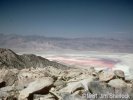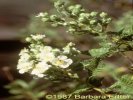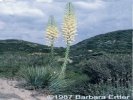 Carl Purpus, Plant
Collector in Western America
Carl Purpus, Plant
Collector in Western America 
Carl A. Purpus Translation by Barbara Ertter
 Carl Purpus, Plant
Collector in Western America Carl Purpus, Plant
Collector in Western America | C. A. Purpus and His Introductions (Continued) |
 | Carl A. Purpus Translation by Barbara Ertter |
 




|
Original Title: C. A. Purpus und seine Einfuhrungen. Moller's Deutsche Gartner-Zeitung. 11(10): 109-112.
|
Herr Purpus reports: | |  Owens Lake from
Olancha Peak, California. Owens Lake from
Olancha Peak, California. Other Articles: Collecting in the Sierra Nevada: 0060 On the Trail…: 0170 Locations: Owens River Valley. Letters: 9/15/1896 "Mount Whitney, the highest peak in
the United States of North America, is surrounded by a group of gigantic summits from 4400 m to nearly 500 m, which create a truly awesome but icy spectacle.
One feels overwhelmed, as if placed in another world, when viewing these gray-white giants.
The stone is a reddish white granite, for the most part with a slate foundation where it penetrates the Silurian. All of these hornlike and toothlike peaks drop precipitously to the east in the literal sense of the word, the easternmost more than 2600-3400 m vertically into the Owens River Valley.
The view from this precipice is truly terrifying. Through the Owens River Valley flows the river of the same name, which empties into a large alkaline lake at the lower end of the valley. The extinct craters of Mt. Whitney are extrmely interesting, where a person sinks noticeably into the tuff and volcanic ash. The landscape west of Mt. Whitney is also marvelously impressive, including Sequoia, Kaweah, and Sawtooth Peaks.
|
|  Foxtail pine on Tawny Point, Bighorn Plateau, California.
Foxtail pine on Tawny Point, Bighorn Plateau, California.
"The high montane
forest is very sparse and consists of two Pinus species, one of which is
probably P. murrayana Engelm. while the other may be P. balfouriana Jeffrey. The former does not go above 3400 m, while the latter reaches its limit between 3700 m to nearly 4000 m. Above this belt Mt. Whitney is everywhere bare, except for here and there a Ribes that bears a certain resemblance to R. cereum and ascends to over 4000 m. Splendid alpines blooming in the most marvelous colors brighten this treeless region. Those that occur the highest include the very rare Draba eurycarpa Gray, previously found only once, the lovely Polemonium confertum Gray, the attractive Primula suffrutescens Gray, Draba lemmoni S. Wats., Carex sp., and others.
|
| "The sparse high
mountain forest lacks underbrush. Only occasionally does one encounter a Ribes
sp., an attractive Jamesia sp., which also ascends higher, or others. At somewhat lower regions,
between 3000 and 3400 m, the shrubby vegetation is richer. Here are found Castanopis chrysophylla,
Arctostaphylos sp. including A. nevadensis, and the various Ribes, including R. menziesii.
|
| Other Articles: Collecting in the Sierra Nevada: 0070 On the Trail…: 0180
"The forests of the lower regions consist of Pinus ponderosa Dougl., P. lambertiana Dougl., P. jeffreyi Murr., Libocedrus decurrens Torr., and Abies concolor Lindl. & Gord., accompanied by scattered Sequoia gigantea Torr. ascending to nearly 2700 m. The hardwoods are represented by Quercus kelloggii Newb., Q. douglasii, Q. chrysolepis, Alnus sp., Populus, and various evergreen and deciduous shrubs. A Juniperus occurring here is identical to one found on Dry Creek in Colorado and is probably J. californica. The sight of the giant trees of Sequoia gigantea is truly awesome.
One feels completely overwhelmed and in another world when one sees these monuments to ages long past for the first time.
|
| "The permanent snow
here is as limited as that in the Rocky Mountains of Colorado. Even the
highest peak of Mt. Whitney is snowfree in midsummer, if only for a short time. However, snowfields
can be found in shady places, ravines, and canyons. The northern Sierra (Mt. Shasta) has permanent
snowfields and even small glaciers.
|
| "The climate of the
eastern Sierra Nevada is significantly harsher than that of the western side.
At the end of August it had already frozen at 2700-3000 m, and the thermometer registered -2 to -3
degrees C. Massive ribbons of ice hang on the rocks where water runs. At 1200 m, my current
location in the western Sierra [near Springville], even figs can thrive without protection, although the
temperature occasionally drops below -6 to -8 degrees C. It snows here every winter, but the snow
does not remain long. On November 4, we had the first snow at +1 degree C; on November 5 the
thermometer dropped to 1 degree below zero. The climate is different at 1600 to 2000, where only
apples and inferior peaches may be grown, and where there are large snowpacks that last until late
spring. At the end of May it froze and snowed heavily in this place. At higher elevations it may have
already become very cold, and in the highest regions a Nordic winter temperature prevails.
|
| "The result of my
high mountain tour was richly productive. I collected seeds from about 200
species. Unfortunately, I had to leave large quantities of high mountain shrubs and perennials behind,
both because I could not wait for the seeds to ripen, and because my pack animal was already so
heavily laden that it would have been impossible for me to add anything more.
|
| "At 3700-4000 m, I
collected the splendid Bryanthus breweri A. Gray, an attractive subshrub with
large purple-red flowers growing on rocks and talus. There was also Ledum glandulosum Nutt.,
which is rarely actually found in cultivation although it is mentioned in dendrological works and
catalogues. This beautiful shrub, found in somewhat moist spots, has broad ovate leaves, punctate
below, and snow-white flowers arranged in false umbels. I then found the very interesting
red-flowered Lonicera conjugialis Kellogg, a splendid unknown Jamesia with rose-red flowers, and attractive Symphoricarpos and Ribes species. On the east side of Mt. Whitney I encountered the marvelous Cercocarpus ledifolius Nutt. I was able to collect seeds of it at the limit of its range, at 3400 m. I also collected seeds of the lovely Castanopsis chrysophylla at 3000 m, so plants grown in Germany from these seeds should be winter-hardy. C. chrysophylla, which grows to a stately tree in deep soil, forms at these heights a loose shrub 1-1 1/4 m high with splendid foliage golden below. The seeds, enclosed in a prickly hull, are similar to hazelnuts and very delicious.
|
|
 Chamaebatiaria millefolium.
Chamaebatiaria millefolium.
"At 2700 m elevation I found Chamaebatia foliolosa Benth., and attractive Rosaceae with large
white flowers that reaches its limits at this elevation. This small shrub often grows together in
masses, filling the woods with its aromatic scent. The densely glandular leaves have a certain
similarity to those of tansy (Tanacetum vulgare). Unfortunately, I coul gather only a few seeds,
because the shrubs at this altitude had hardly produced any. Between 2700 and 3000 m, I also found
a splendid Arctostaphylos 1-1 1/4 m tall with rose-red flowers, and the graceful decumbent A.
nevadensis with white racemes.
|
| "The shrubby
Penstemon growing at these altitudes are wonderfully beautiful, such as P. bridgesii Gray, with its splendid scarlet flowers, golden within, and the stunning P. menziesii Hook. var. newberryi Gray, with large purple-red flowers. Rocky areas covered with these Penstemon offer a sight that is truly indescribable. The beautiful yellow-flowerd P. breviflorus Lindl., to 2 1/2 m tall, and the subshrubby P. azureus Benth., to 30 cm tall with magnificent azure flowers, reach their limits at 2400 m.
|
| "Suffruticose
Eriogonum occurring between 2400 and 3000 m are also attractive cliff shrubs,
such as E. stellatum Benth., ca 30 cm tall with golden yellow umbels, and E. nivale with woolly snow-white leaves. Haplopappus cuneatus Gray, a Compositae with that resembles a Sedum in form, is also attractive. The suffrutescent Corethrogyne filaginifolia Nutt. var. tomentosa Gray with its marvelous silky blue flowers, Tanacetum canum Eaton, Artemisia rothrockii Gray, attractive Bigelowia, and other species occur on rocks at higher elevations. At 2700-3000 m I found Ribes viscosissimum, a lovely Ribes sp. with large bell-shaped flowers.
|
| "The attractive low
shrubs Ceanothus parviflorus Trelease and C. pinetorum Coville grew between 2400 and 2700 m, along with the very interesting Garrya (G. flavescens?), which provides a splendid sight, not only in the finery of its catkins, but also when laden with fruit.
|
| "At lower elevations,
between 1700 and 2000 m, I encountered the magnificent Fremontia
californica Torr., a first rate display shrub with large yellow malvaceous [actually Sterculiaceae]
flowers. The fruiting capsules are covered with detestable prickly hairs, as obnoxious as those of
Opuntia. The fruits of Castanopsis are equally unpleasant, such that I had to use a thick leather glove
to collect both. Although Fremontia ascends higher than 2000 m, its seeds from that altitude are
sterile. In the same region I also found Ceanothus integerrimus Hook. & Arn. and another Ceanothus species. The former grows up to 3 m tall and has long panicles of white flowers. The flowers of the latter are light blue. In addition I found the lovely Staphylea bolanderi Gray, an attractive flowering shrub with lily-like white flowers, often rose-tinged, Philadelphus lewisii Pursh, Ceanothus dentatus Torr. & Gray, the magnificent Adenostoma fasciculatum Hook. & Arn., the splendid Papaveraceae Dendromecon rigidum Benth. with its large yellow flowers resembling those of Eschscholtzia californica, and Diplacus sp., a marvelous flowering shrub with large yellow flowers flecked with orange.
|
|  Yucca whipplei.
Yucca whipplei.
"At 2000 m I encountered the splendid Yucca whipplei Torr. at the limits of its range. Plants
grown in Germany from seed may survive if covered during snowless winters. Likewise I succeeded
in gathering seeds of Sequoia gigantea Torr. from the edge of its range at nearly 2500 m. This plant
may also prove to be completely winter-hardy in middle Germany. The reason that Sequoia is often
so poorly hardy in Germany is undoubtedly because the seeds from which the plants were raised were
collected in the lower regions (the species occurs to 1400 m) and only rarely from populations at
higher elevations in harsher climates.
| |
[Previous Page] [Next Page] | |
| [Published Biographies] [Travelogues and Articles] [Letters] [Plant Lists and Bibliography] [Site Administration] | | Date and time this article was prepared: 6/7/2002 7:32:07 PM |